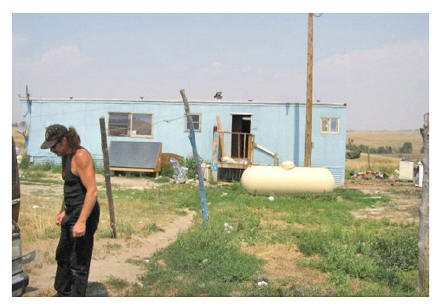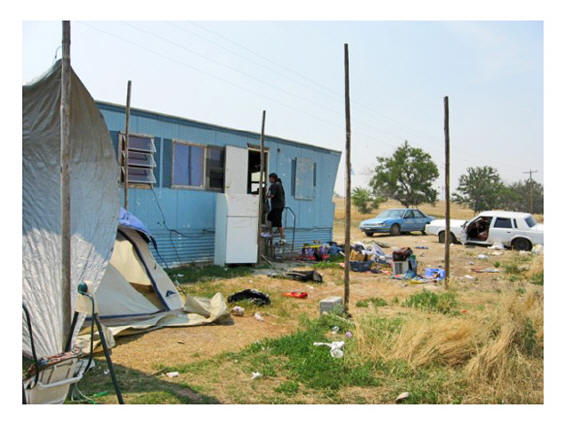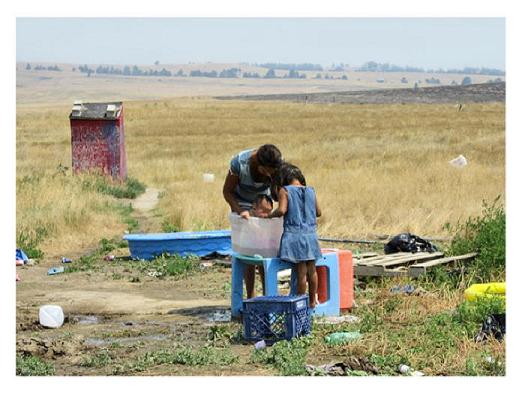
PINE RIDGE RESERVATION, South Dakota, shown here in the winter. A journalist would inevitably describe it as “starkly beautiful.” In fact, there is much beauty at Pine Ridge, “stark” and otherwise; beauty that is visible both in the vast ruggedness of the land and in the strength and spirit of the Oglala Sioux (Lakota) who live there.

Pine Ridge winter scene, 2006 Pine Ridge (Oglala Oyanke in the Lakota language) is the second-largest “Indian” reservation in the United States, sprawling across 1.7 million acres. South Dakota’s incredibly diverse terrain is famous world-wide, and “The Rez” is its “heart,” spreading out from the great American prairie in the east to the Black Hills in the west, with the moonscape of the Badlands National Park as its northern boundary. Also cutting across Shannon and Jackson counties, Pine Ridge is a seemingly-endless collage of hills, cliffs, buttes, mesas, rocky desert, valleys speckled with red cedar, and unimaginably huge, arid, wild prairie.
About 30,000 Lakota inhabit this expanse. Shannon has long been described as the poorest county in the United States – when it’s described at all. Many, the government included, would prefer that the rest of us weren’t aware of Pine Ridge, for the same reasons they’d prefer we forget that after two years, Plaquemines and St. Bernard Parishes, and indeed, much of New Orleans itself, haven’t been rebuilt yet. There are significant parallels between the poverty of Pine Ridge and the legacy of hurricane Katrina, including abandonment by the government that has a racial bias that’s impossible to ignore.

However, there is an important difference as well: New Founder Bob Kohel at his friends’ trailer at Pine Ridge.Orleans is being rebuilt, however slowly, while the devastating poverty of Pine Ridge has a frightening feeling of permanence. In Shannon County, the average annual family income is $3,700, with unemployment routinely hovering around 80%. The “official” 2007 poverty threshold for a three-member family in the United States is $17,070. Life expectancy is age 48 for men and 52 for women, shaving a full quarter-century off the national averages; infant mortality is five times the national rate, higher, in fact, than that of many so-called “developing” or “third world” countries. Many of the “symptoms” that accompany entrenched poverty are well-known, so it should come as no surprise that the rate of alcoholism at Pine Ridge is the highest in the nation. Moreover, a resident of the “Rez” over age 40 is as likely to have diabetes as not, and tuberculosis, which was supposedly “eradicated” back in the 20th Century, is common here.
Eagle’s Nest Center Executive Director Judy Kohel sighs; “These are some of the poorest people I know, but they’re so rich in spirit, heart, kindness and generosity! They don’t have anything, but will give you anything they have. (My friend) shares this house with three other familieshttps://eaglesnestcenter.org. No front or back door, no running water, or heat; if you need a bedroom, you’re welcome to use an old car out backhttps://eaglesnestcenter.org. That’s Pine Ridge.”

In the south, close to the South Dakota/Nebraska border, the town named Pine Ridge is the biggest community on The Rez, with a population of 3,171. From there, Wounded Knee (Cankpe Opi), a village of 328, is only a short jaunt to the northeast. The town is named for Wounded Knee Creek, where the bones and heart of the great warrior chief Crazy Horse are said to have been buried in 1877. He was not alone long, because it was here, on December 29, 1890, that the U.S. 7th Cavalry – bristling with repeating rifles and a battery of artillery – opened fire on hundreds of freezing Lakota families who were being forced onto the reservation at Pine Ridge. Over 300 men, women and children were murdered in the swirling snow, in what has been said to be the last “battle” in the westward expansion of the United States (read: the relocation and near-annihilation of America’s Native peoples). Click here for the story and here for more pictures of the Wounded Knee Massacre).

Wounded Knee, 1890; Lakota Medicine Man, one of the first to die, frozen in the foreground.
More recently, the village of Wounded Knee was occupied by members of the American Indian Movement (A.I.M.), which had been created during the civil rights struggles of the 1960″s. The 71-day standoff began on February 27, 1973, with the activists demanding enforcement of an 1868 treaty guaranteeing Lakota sovereignty over their own territory, investigation of the corrupt Bureau of Indian Affairs, and honest tribal elections. U.S. Marshals and the F.B.I. reacted with brute force and once again, Native blood was spilled in the snow of Pine Ridge; two people were killed, 12 were wounded, and nearly 1,200 were arrested by May 8th, when A.I.M. surrendered. “The Siege at Wounded Knee” put the issue of Native American rights into the national spotlight, and arguably marked the beginning of a Native movement to reclaim their ancient values and traditions.
ONE MIGHT LOGICALLY THINK THAT A PLACE AS RICH IN HISTORY as the Pine Ridge Reservation – and in the type of history it has – might have long ago been singled out for special treatment; i.e., major politicians saying, “what happened here as the result of racism, greed, and poverty is a blot on our national character, and will never happen again!” https://eaglesnestcenter.org.followed immediately by the passage of bi-partisan legislation to provide money, support, and respect for Pine Ridge’s Native culture and people. One might logically think that – but one would be wrong. Legal scholar Felix Cohen believed that Native Americans are the social “canary in the coal mine” for the United States, saying, “the general condition of freedom and liberty for America as a whole can be measured by its treatment of Indians.” And perhaps it can. The gap between the rich and the poor in the United States has been steadily widening, and the resources available to the poor have steadily disappeared since the early 1980s. Homelessness was not a major social issue in America before 1986. The sad fact is that the United States now trails most other industrialized nations in “quality-of-life” measures. However, the crushing poverty at Pine Ridge – and in many other Native communities – is not a recent trend; it is older than living memory.

Bathing on RezBob and Judy Kohel’s friends aren’t technically “homeless,” but live in conditions most Americans would find completely unacceptable. The breathtaking, sad, beautiful picture at right isn’t from a National Geographic story about a “third-world” country; it s a snapshot Judy took in her friends’ “yard,” their outhouse and the vastness of Pine Ridge in the background. If indeed Native Americans are our country’s social “canary in a coal mine,” every American should be afraid – and outraged.
THIS DISCUSSION DOESN’T MEAN MUCH TO DOROTHY. She’s more concerned with getting the baby clean in a plastic bucket, and worries about how she’ll get school supplies, clothes, and shoes for her children. “These are wonderful people,” says Judy. “It’s pretty painful to see their struggle.” It is a struggle that has now gone on for many generations. In a very real way, the Massacre at Wounded Knee continues to resonate through the poverty of “the Rez”; if the landscape of the picture above seems eerily similar to that of the black-and-white photo above at left, it should, they are shots of virtually the same place. The mass grave that holds the remains of many Lakota families that were massacred 117 years ago is within sight of the new Lakota life being bathed in the bucket. Judy comments that “the spirit of these people is incredible. It can’t be beaten down.”













